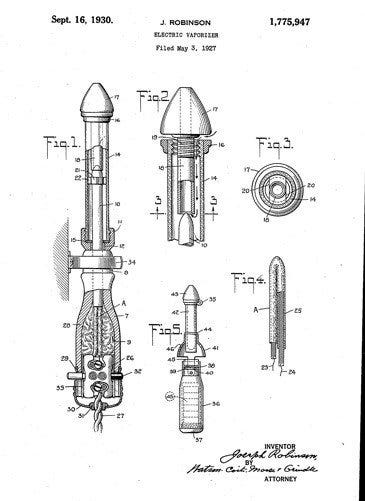While never commercially produced, Joseph Robinson’s 1930 patent (US#1932657, filed 1927) is a foundational piece in the history of vaping due to several key facts:
1. Earliest Known Patent for an “Electronic” Inhaler Concept
Robinson’s device is the first documented instance of explicitly using electrical heating to vaporize a medicinal compound for inhalation without combustion. This core principle underlies modern vaping.

2. Established the Core Operating Principle
The patent detailed a device using an electrically heated element placed within a liquid solution, generating an “incense-like vapor” (using a holder/pipe apparatus). This directly parallels the fundamental mechanism of e-cigarettes.
3. Recognized Vaporization vs. Combustion
Robinson explicitly aimed for vaporization as a method for delivering compounds without creating harmful smoke or irritating the throat. While intended for medical compounds, this distinction is central to vaping’s rationale.
4. Pioneered Concept Later Rediscovered
Though forgotten for decades, the patent serves as prior art demonstrating the early conceptualization of electrical vaporization. Modern pioneers, like Hon Lik, would develop functional, miniaturized versions based on this similar core concept in the early 2000s.
5. Legal and Historical Recognition
Robinson’s patent is frequently cited in historical timelines and sometimes within legal contexts related to vaping intellectual property and regulation, acknowledging its foundational role as the conceptual predecessor.










